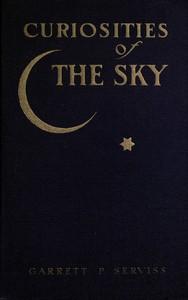|
|
Read this ebook for free! No credit card needed, absolutely nothing to pay.Words: 54555 in 8 pages
This is an ebook sharing website. You can read the uploaded ebooks for free here. No credit cards needed, nothing to pay. If you want to own a digital copy of the ebook, or want to read offline with your favorite ebook-reader, then you can choose to buy and download the ebook.

: Curiosities of the Sky by Serviss Garrett Putman - Astronomy Science Fiction; Astronomy@FreeBooksTue 06 Jun, 2023 Great spiral nebula in Andromeda The Milky Way Star-cluster in Hercules Great southern star-cluster, Omega Centauri The Pleiades The "Great Dipper" Cassiopeia The "Northern Crown" The "Southern Cross" Chart showing location of Tycho's star, 1572, and Nova Persei of 1901 Nova Persei, with its nebular rings Lord Rosse's nebula Wonderful spiral in triangulum Spiral in Ursa Major Nebula in Cetus The Orion nebula The Corona A solar "prominence" Auroral beams seen in England Auroral arches of an eliptic form seen in the Arctic regions Auroral curtain seen in Scandinavia Auroral arches seen in Scandinavia Swift's comet Daniels' comet Brooks' comet Curious forms of meteorite trains Section of the atmosphere up to 100 kilometers A meteor photographed in flight Looking across Coon Butte crater from northern rim Trail on south side, Coon Butte crater The craters Clavius, Longomontanus, Tycho, etc. Western part of the Mare Serenitatis Mare Tranquilitatis and surroundings Lunar craters Theophilus and surrounding region Mare Crisium Schiaparelli's chart of Mars, showing the so-called system of canals PREFACE What Froude says of history is true also of astronomy: it is the most impressive where it transcends explanation. It is not the mathematics of astronomy, but the wonder and the mystery that seize upon the imagination. The calculation of an eclipse owes all its prestige to the sublimity of its data; the operation, in itself, requires no more mental effort than the preparation of a railway time-table. The dominion which astronomy has always held over the minds of men is akin to that of poetry; when the former becomes merely instructive and the latter purely didactic, both lose their power over the imagination. Astronomy is known as the oldest of the sciences, and it will be the longest-lived because it will always have arcana that have not been penetrated. Some of the things described in this book are little known to the average reader, while others are well known; but all possess the fascination of whatever is strange, marvelous, obscure, or mysterious--magnified, in this case, by the portentous scale of the phenomena. The idea of the author is to tell about these things in plain language, but with as much scientific accuracy as plain language will permit, showing the wonder that is in them without getting away from the facts. Most of them have hitherto been discussed only in technical form, and in treatises that the general public seldom sees and never reads. Among the topics touched upon are: The strange unfixedness of the "fixed stars," the vast migrations of the suns and worlds constituting the universe. The slow passing out of existence of those collocations of stars which for thousands of years have formed famous "constellations," preserving the memory of mythological heroes and heroines, and perhaps of otherwise unrecorded history. The tendency of stars to assemble in immense clouds, swarms, and clusters. The existence in some of the richest regions of the universe of absolutely black, starless gaps, deeps, or holes, as if one were looking out of a window into the murkiest night. The marvelous phenomena of new, or temporary, stars, which appear as suddenly as conflagrations, and often turn into something else as eccentric as themselves. The amazing forms of the "whirlpool," "spiral," "pinwheel," and "lace," or "tress," nebulae. Free books android app tbrJar TBR JAR Read Free books online gutenberg More posts by @FreeBooks
: Mr. Midshipman Easy by Marryat Frederick - Sea stories; Autobiographical fiction; War stories; Young men Fiction; Adventure stories; Napoleonic Wars 1800-1815 Fiction; Great Britain History Naval 19th century Fiction; Midshipmen Fiction Napoleonic(Bookshel@FreeBooksTue 06 Jun, 2023

: The Life Crime and Capture of John Wilkes Booth by Townsend George Alfred - Booth John Wilkes 1838-1865; Assassins United States Biography; Lincoln Abraham 1809-1865 Assassination Crime Nonfiction@FreeBooksTue 06 Jun, 2023
|
Terms of Use Stock Market News! © gutenberg.org.in2025 All Rights reserved.






